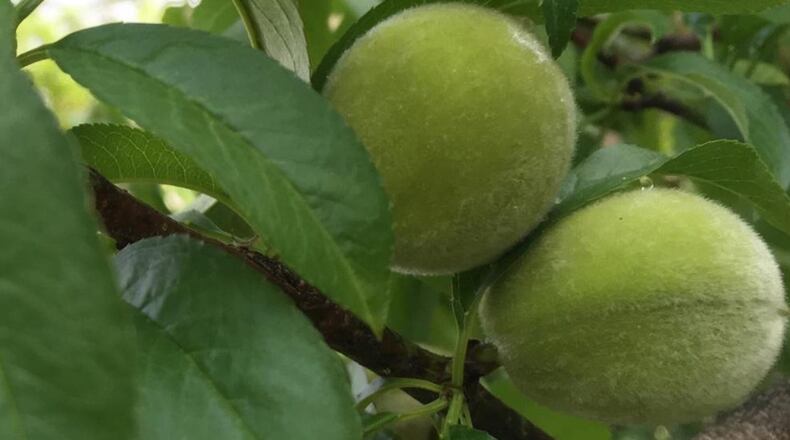Q: Do I need to plant two peach trees to grow fruit? Pamela Chance, Doraville
A: No, peach flowers contain both male and female organs, so each flower can pollinate itself. No pollinator peach is needed. That said, if you plant two different varieties of peach, your harvest may be a little larger due to the invigorating effect of two slightly different genetic combinations getting together.
>> RELATED: Georgia peach growers tout the biggest crop in years
Q: As I was walking in my backyard, I noticed a few low spots. I got a narrow shovel and excavated. Two of the low spots revealed large cavities below the surface, about 18 inches deep and 6 inches in diameter. What could cause this? George Carpenter, email
A: Put on gloves and reach into a hole to see how it is lined. My neighbor observed the exact same thing, and she came up with a handful of pine bark lining her landscape hole. I think both situations were caused by small pine trees being taken down during the home's construction several years ago. Their trunks rotted underground. Eventually a small cavern was made and some of the covering subsided to make a noticeable low spot in the ground. I have pictures and descriptions of several kinds of landscape holes at bit.ly/GAholes.
Q: After several years of buildup, I need to dethatch my Bermuda. Should I use a vertical mower or can I use a dethatching blade on my rotary mower? When? Joe Mascitti, email
A: Dethatching is not needed if you are maintaining your lawn correctly. Using the right amount of fertilizer and mowing at the correct height will eliminate the need to remove a thatch layer. But if you are forced to do so in order to get on the right track, early June is the right time. Whether you use a vertical mower or a dethatching blade, set it just high enough to pick up thatch but not to dig into the dirt. Be aware that dethatching will produce a lot of plant material that will have to be raked up. In my opinion, a good aeration will accomplish the same as dethatching without the inevitable damage.
Q: I have been growing onions for years, always with poor results. The onions never grow large; they barely get larger than the size originally planted. I put them in anywhere between January and March. I've tried Yellow Granex, Burgundy Red, and Texas Sweet but never a big bulb. Andy Wilkerson, LaGrange
A: You did not plant early enough. Short-day onions like these should be planted in fall, usually in October. This gives them lots of time to grow leaves before bulb formation is triggered to begin in January. Onions can tolerate most winter weather, but cover yours if temperatures in the teens approach. When the leafy tops begin to turn yellow and fall over, your onions are ready to dig. Be sure to fertilize and water appropriately. I have an excellent garden calendar at bit.ly/GAgardcal.
Listen to Walter Reeves’ segments at 6:35 a.m. on “Green and Growing with Ashley Frasca” Saturday mornings on 95.5 WSB. Visit his website, www.walterreeves.com, follow him on Twitter @walterreeves, on Pinterest, or join his Facebook Fan Page at bit.ly/georgiagardener for more garden tips.
About the Author
The Latest
Featured

